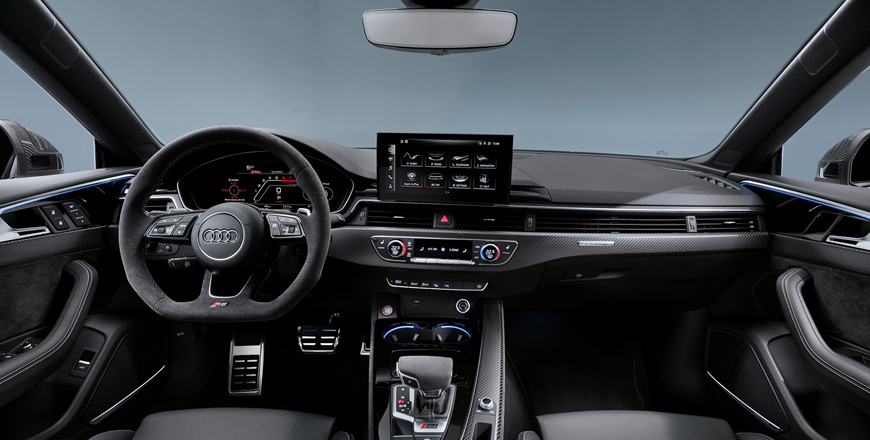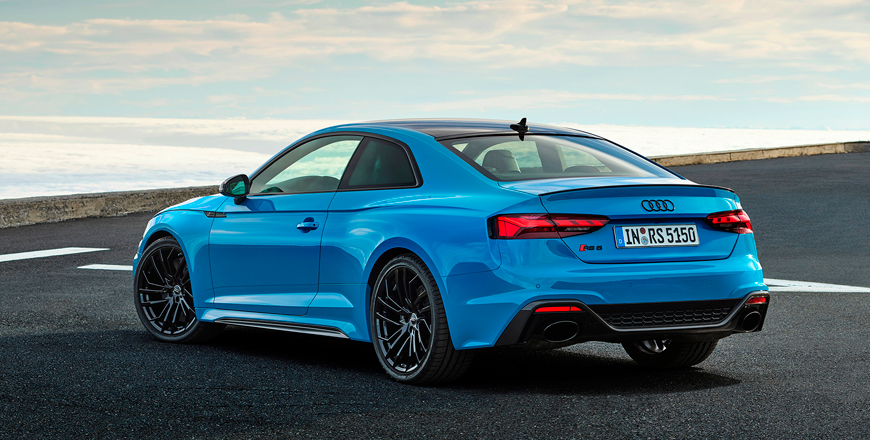You are here
Audi RS5 Coupe: Quick and confident, handsomely assertive callback beast
By Ghaith Madadha - Aug 22,2022 - Last updated at Aug 22,2022

Photos courtesy of Audi
The modern day successor to the game-changing 1980-91 Audi Quattro that popularised four-wheel-drive for motorsport and production performance cars, the Audi RS5 Coupe is an enormously capable compact performance two-door, four-seater.
First introduced in its second generation in 2017 and soon mildly face-lifted in 2019, the RS5 Coupe’s only flaw is perhaps the fact that it is such a well-rounded and accomplished interpretation and evolution of the practical performance Audi coupe, and lacks the foibles and edginess that conversely made its formidable historic predecessor so enduringly charismatic.
Assertive aesthetic
The most powerful iteration of the Audi A5 executive coupe model line, the RS5 Coupe is a handsomely assertive beast rooted in modern Audi design sensibilities, but bearing some small callbacks to the iconic original Quattro, including its rear pillar angle and short, almost fastback-like bootlid. With a long bonnet and elegantly short front overhang, the RS5 visually minimises the Quattro drive-line’s traditionally nose-heavy layout. With enormous gaping grille and slim, scowling headlights, the RS5 Coupe’s stylised aggression meanwhile includes huge front lower intakes, lower lip, defined sills and a discrete rear spoiler.
In addition to lightly restyled bumpers and lights, the refreshed 2019 RS5 Coupe’s already broad wheel-arches are meanwhile slightly widened as another callback to the original Quattro and its distinctively blistered and beefy wheel-arches, even though the link was not heavily underlined in 2017. That said, the RS5 Coupe is a handsomely athletic design in its own right. But with a curvier waistline, more rounded edges and more emphasised styling, is a different animal than the Quattro and its purer, more distilled sense of drama with its use of straight-cut lines, sharp angles and less stylisation.

Prodigious performer
Built on an evolution of the same architectural layout used by the 1980s Quattro with the engine mounted low and forward of the front axle to power all wheels, the RS5’s longitudinally shorter engine is drawn further back for better weighting. Meanwhile its four-wheel-drive system is significantly more advanced in the way it manages power distribution. Probably the most agile application of the Quattro system layout, the RS5 Coupe’s handling is not as starkly different from more balanced but less grippy rear-drive rivals as the original Quattro was compared to its own contemporary rivals.
Powered by a twin-turbocharged 2.9-litre V6 engine in place of its predecessor’s naturally-aspirated 4.2-litre V8, the RS5 Coupe’s lighter, smaller and more efficient engine, however, gives nothing away in performance or output. Unchanged since its 2019 face-lift, the RS5’s prodigious V6 develops 444BHP at 5700-6700rpm and a mighty 442lb/ft dose of torque throughout a broad, accessible and versatile 1900-5000rpm plateau. Driving its tenaciously grippy Quattro four-wheel-drive through a quick-shifting 8-speed gearbox, and with responsively quick-spooling turbos, the RS5 pounces off the line and rockets through 0-100km/h in just 3.9-seconds.

Character and comfort
If not quite as its high-revving as its wailing high-strung 8,250rpm capable RS5 predecessor or as charismatically burbling as the original Quattro’s turbocharged in-line 5-cylinder engine, the modern RS5’s engine, however, delivers a bigger and wider mid-range torque sweet spot to allow for muscularly effortless on the move acceleration, in addition to an explosively powerful top-end and electronically-governed 250km/h top speed. Meanwhile, and with the aid of its stop/start system, it returns moderate 8.7l/100km combined cycle consumption, for such a high performance car that tips the scales at around 1.7-tonnes.
Taking on different characteristics depending on various driving modes and individually adjustable settings, the RS5 is smooth, refined, quiet and acoustically docile in Comfort mode. However, switching to a more aggressive setting, the RS5 takes on a snarling soundtrack and more vocal exhaust note. An accessible and effortless daily drive with far more luxury and equipment than its distant predecessor, the RS5 is manoeuvrable in town with light Comfort mode steering, refined cabin, high speed stability and reassuring cornering over low traction surfaces.
Quattro control
If too user-friendly for a performance coupe, the RS5’s character and controls become sharper and more focused in Dynamic mode. Meanwhile, with five-link suspension and rear-biased four-wheel-drive making it more crisply eager and agile turn-in than its heavy-nosed historical Quattro predecessor, the RS5 may not quite need the same aggressive driving style to get the best of it. Nevertheless is similarly responds well to throttle lift-off or a dab of braking to shift weight and tighten a cornering, before coming back hard on the throttle for its four-wheel-drive and optional rear “sport” differential to regain traction.
A more rewarding drive when pushed hard and closer to its limits, the RS5 is highly capable through corners, where its four-wheel-drive reapportions power as needed to ensure high levels of road-holding and allows it to carry speed with confidence. Smooth and firm without being uncomfortable over rougher road sections, the RS5’s suspension meanwhile provided good lateral and vertical control. Its supportive sports seats and well-adjustable driving position meanwhile keep one feeling involved of proceedings, while steering is quick and direct, if slightly light and clinical.
TECHNICAL SPECIFICATIONS
- Engine: 2.9-litre, twin-turbocharged, in-line V6-cylinders
- Bore x stroke: 84.5 x 86mm
- Compression ratio: 10:1
- Valve-train: 24-valve, DOHC, direct injection
- Gearbox: 8-speed automatic, four-wheel-drive
- Ratios: 1st 5.0; 2nd 3.2; 3rd 2.143; 4th 1.72; 5th 1.313; 6th 1.0; 7th 0.823; 8th 0.64
- Reverse/final drive: 3.478/3.204
- Drive-line: Self-locking centre differential, optional rear sport differential
- Power, BHP (PS) [kW]: 444 (450) [331] @5,700-6,700rpm
- Specific power: 153.3BHP/litre
- Power-to-weight: 262BHP/tonne (unladen)
- Torque, lb/ft (Nm): 442.5 (600) @1,900-5,000rpm
- Specific torque: 207.3Nm/litre
- Torque-to-weight: 354Nm/tonne (unladen)
- 0-100km/h: 3.9-seconds
- Top speed: 250km/h (electronically-governed)
- Fuel consumption, combined: 8.7-litres/100km
- CO2 emissions, combined: 199g/km
- Fuel capacity: 58-litres
- Wheelbase: 2,766mm
- Aerodynamic drag co-efficient: 0.32
- Unladen/kerb weight: 1,695/1,770kg
- Steering: Electric-assisted rack & pinion
- Turning Circle: 11.7-metres
- Suspension: Five-link, tubular anti-roll bars
- Brakes: Ventilated discs, 375mm/330mm
- Tyres: 265/35ZR19
Related Articles
By virtue of occupying the same position in Audi’s range as a high performance coupe variant based on the same basic platform as the brand’s
Launched last year, the Audi RS5 Sportback is an intersection between the descendants of two of Ingolstadt manufacturer’s most iconic cars,
First launched in 2010 as the Ingolstadt manufacturer’s dramatic, sure-footed and user-friendly alternative to the fashionable Mercedes-Benz














